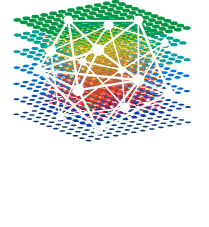Program of the Conference
The program is in Madrid time zone (CET)
Tutorial Schedule
Conference Schedule
The detailed program of the conference is also available at Easychair Smart Program.
Day 1 - Morning (8:45 - 12:50) - Tue, 30 Nov
Day 1 - Afternoon (14:15 - 19:35) - Tue, 30 Nov
|
14:15-16:15 Session Oral O2A: Network Models & Motifs
14:15-16:15 Session Oral O2B: Human Behavior
14:15-16:15 Session Oral O2C: Network Analysis & Measures
16:15-16:55Coffee Break
16:15-16:55 Session Poster P2A: [1-11] Network Analysis & Measures
16:15-16:55 Session Poster P2B: [12-18] Network Medicine
16:15-16:55 Session Poster P2C: [19-22] Networks in Finance & Economics
16:55-17:35 Session Speaker S2: Yizhou Sun - Graph-based Neural ODEs for Learning Dynamical Systems
17:35-19:35 Session Oral O3A: Dynamics on/of Networks
17:35-19:35 Session Oral O3B: Structural Network Measures
17:35-19:35 Session Oral O3C: Network Embedding
|
Day 2 - Morning (8:45 - 12:50) - Wed, 1 Dec
|
Wednesday, December 1st
9:00-9:40 Session Speaker S3: João Gama - Mining Evolving Large-Scale Networks
9:40-10:40 Session Lightning L2: Networks in Finance & Economics - Dynamics on/of Networks
10:40-11:20Coffee Break
10:40-11:20 Session Poster P3A: [1-12] Diffusion & Epidemics
10:40-11:20 Session Poster P3B: [13-19] Biological Networks
10:40-11:20 Session Poster P3C: [20-22] Motifs
11:20-12:50 Session Oral O4A: Information Spreading in Social Media
11:20-12:50 Session Oral O4B: Networks in Finance & Economics
11:20-12:50 Session Oral O4C: Temporal Networks
12:50-14:15Lunch Break
|
Day 2 - Afternoon (14:15 - 19:35) - Wed, 1 Dec
|
14:15-16:15 Session Oral O5A: Structural Network Measures
14:15-16:15 Session Oral O5B: Diffusion & Epidemics
14:15-16:15 Session Oral O5C: Resilience, Synchronization & Control
16:15-16:55Coffee Break
16:15-16:55 Session Poster P4A: [1-9] Information Spreading in Social Media
16:15-16:55 Session Poster P4B: [10-15] Dynamics on/of Networks
16:15-16:55 Session Poster P4C: [16-20] Structural Network Measures
16:55-17:35 Session Speaker S4: Alessandro Vespignani - Computational Epidemiology at the time of COVID-19
17:35-19:50 Session Oral O6A: Network Models
17:35-19:35 Session Oral O6B: Human Behavior
17:35-19:35 Session Oral O6C: Biological Networks
|
Day 3 - Morning (8:45 - 12:50) - Thurs, 2 Dec
|
Thursday, December 2nd
9:00-9:40 Session Speaker S5: Ginestra Bianconi - Higher-order networks and their dynamics
09:40-10:40 Session Lightning L3: Networks Analysis & Measures - Diffusion & Epidemics
10:40-11:15Coffee Break
10:40-11:15 Session Poster P5A: [1-9] Human Behavior
10:40-11:15 Session Poster P5B: [10-17] Networks Models
10:40-11:15 Session Poster P5C: [18-21] Community Structure
11:15-13:00 Session Oral O7A: Network Geometry
11:15-13:00 Session Oral O7B: Network Medicine
11:15-13:00 Session Oral O7C: Urban Systems & Networks
13:00-14:15Lunch Break
|
Day 3 - Afternoon (14:15 - 19:35) - Thurs, 2 Dec
|
14:15-15:45 Session Oral O8A: Community Structure
14:15-15:45 Session Oral O8B: Networks in Finance & Economics
14:15-15:45 Session Oral O8C: Resilience, Synchronization & Control
15:45-16:20Coffee Break
16:20-17:00 Session Speaker S6: Dirk Helbing - How Networks Can Change Everything for Better or for Worse
17:00-18:15 Session Oral O9A: Diffusion & Epidemics
17:00-18:15 Session Oral O9B: Information Spreading in Social Media
17:00-18:15 Session Oral O9C: Ecological Networks and Food Webs
|

Recent Comments